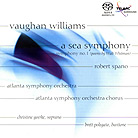August 2002
Robert Spano, who may be best known for his first Telarc recording with the ASO, Rimsky-Korsakov’s Sheherazade and Russian Easter Overture, has returned to the Atlanta’s Symphony to lead them in a performance of A Sea Symphony with soloists Christine Goerke (soprano) and Brett Polegato (baritone). Also featured is the Atlanta Symphony Chorus -- winners of Grammy Awards for multiple Best Choral Performances, including the Berlioz Requiem; Hindemith’s When Lilacs Last in the Dooryard Bloom’d; the Verdi Requiem; Walton’s Belshazzar’s Feast; John Adams' Harmonium paired with Rachmaninoff's The Bells; and a disc of choral masterpieces by Barber, Bartók, and Vaughan Williams. In the tradition of many a Telarc recording, A Sea Symphony is a big and entertaining piece that succeeds not only through the wonderful melodies and superb vocal performances, but also for its dynamic contrasts and infinite shadings, all of which contribute significantly to the musical drama. Varying dynamic intensities and tempos make for a musical experience as stirring to the soul as it is to the intellect. Mostly upbeat and bright, the spirit of A Sea Symphony is lacking the darker and brooding moods of some of Vaughan Williams’ Russian colleagues, but it is every bit as compelling. Telarc is recording a lot of oratorios, and they make excellent use of the surround format. Unlike orchestral works, the choral pieces seem to have different acoustic characteristics and thus make better use of the surround channels. They do a superb job of immersing the listener in the event without the need for resorting to silly placement of instruments around the room. For this reason Telarc’s A Sea Symphony is yet another excellent demo disc for the newly surround-indoctrinated. However, I downgraded the sound-quality rating a bit because to my ears the disc makes too much use of the rear channels. Frequently the chorus voices spill heavily into the surround speakers. The problem is that they are simultaneously in the front channels and unless the speakers are perfectly arranged (as few are, I’m sure) it has the effect of confusing the frontal imaging and even causes a smearing of detail. When properly reproduced, the disc creates a very natural front image and makes very subtle use of the center speaker, thereby greatly relying on the stereo effect. The duplication from the rear channels goes a long way toward confusing that image and creating an overall fuzziness. What I eventually did was turn down the rear channels a few dBs, which alleviated the effect and left me with a clearly defined soundstage. But this had the effect of limiting the surround effect when the chorus was silent. Otherwise, the disc is marvelously recorded whether you listen in two-channel stereo or in surround SACD. Dynamics are first-rate, as is overall clarity. All in all, A Sea Symphony makes for an impressive surround presentation as well as being a musical performance that will provide joy long after the novelty of surround has worn off. Non-surround listeners will do well to pick this one up too, as it’s a great stereo experience. GO BACK TO: |
 Vaughan Williams - A Sea Symphony
Vaughan Williams - A Sea Symphony![[Reviewed on Multichannel SACD]](../format/multichannelsacd.gif) Ralph Vaughan Williams' epic setting of
texts by Walt Whitman was his first and most challenging of symphonic works. It is
reported that as an organist and choir director Vaughan Williams was confident of his
writing ability for chorus but found himself in uneasy waters in the orchestral arena.
Reportedly he worked with composer Maurice Ravel in Paris for three months before feeling
confident enough to complete A Sea Symphony. It premiered in 1910 with four
movements: "A Song for All Seas, All Ships;" "On the Beach at Night,
Alone;" "Scherzo: The Waves;" and the final, movement, "The
Explorers."
Ralph Vaughan Williams' epic setting of
texts by Walt Whitman was his first and most challenging of symphonic works. It is
reported that as an organist and choir director Vaughan Williams was confident of his
writing ability for chorus but found himself in uneasy waters in the orchestral arena.
Reportedly he worked with composer Maurice Ravel in Paris for three months before feeling
confident enough to complete A Sea Symphony. It premiered in 1910 with four
movements: "A Song for All Seas, All Ships;" "On the Beach at Night,
Alone;" "Scherzo: The Waves;" and the final, movement, "The
Explorers."